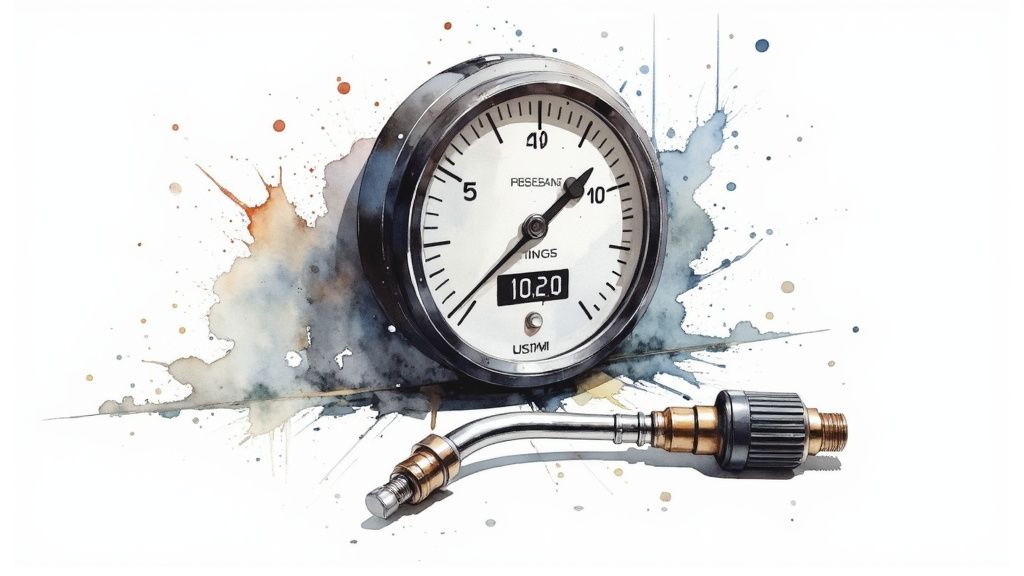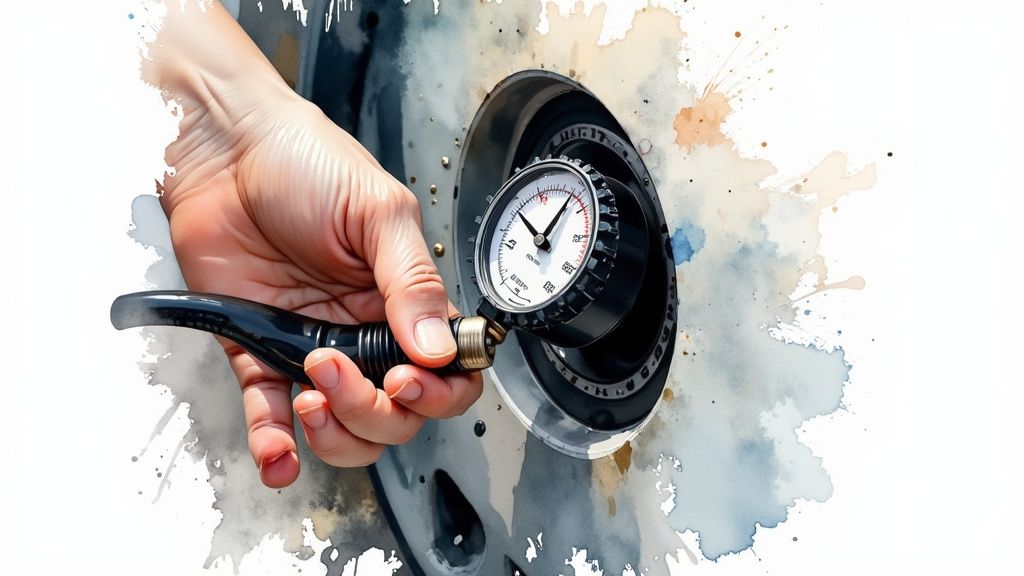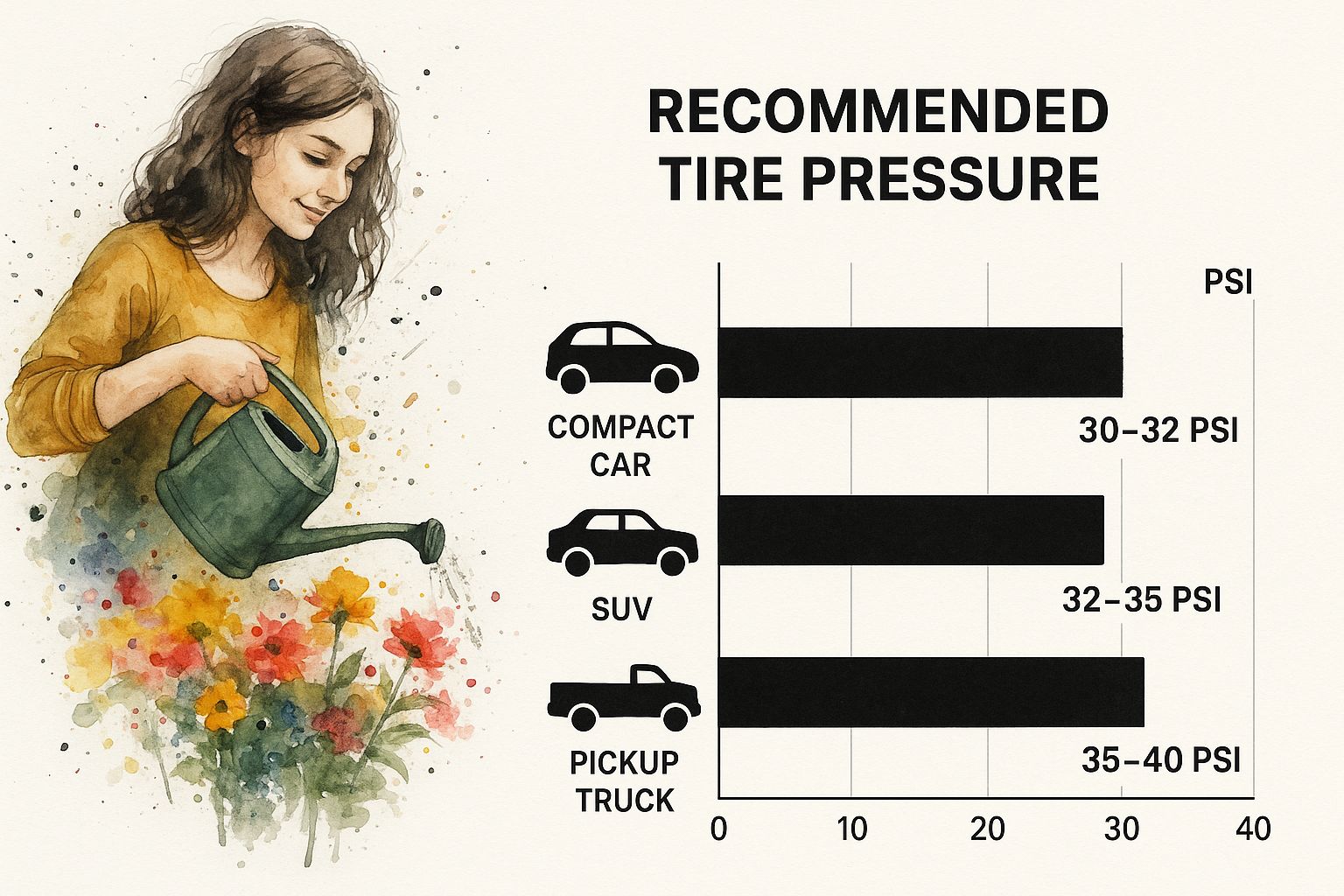
Kwik Kar Service Coupon
Get upto $20 OFF on all services.
Proper tire pressure is crucial for vehicle safety, performance, and fuel efficiency. Your tires are the connection between your car and the road, and the contact patch, where the rubber meets the road, is directly affected by tire pressure. This seemingly minor detail significantly impacts handling, braking, and fuel consumption. Maintaining correct tire pressure is as important as routine maintenance like tire rotation.
Correct pressure ensures an optimal contact patch, maximizing grip and stability. Imagine balancing on a deflated balloon compared to a fully inflated one. The inflated balloon offers a stable base, much like a properly inflated tire provides a secure connection to the road. This results in better handling, shorter stopping distances, and improved control. Proper inflation also promotes even tread wear, extending the life of your tires.
Furthermore, correct tire pressure significantly affects fuel efficiency. Underinflated tires increase rolling resistance, forcing the engine to work harder and consume more fuel. Overinflating tires reduces the contact patch, creating a harsher ride and decreasing traction. This can be particularly dangerous in bad weather. Incorrect tire pressure contributes significantly to road safety risks and economic losses worldwide. Maintaining correct tire pressure can improve fuel economy by up to 3.3%, according to the U.S. Department of Energy, and improperly inflated tires can reduce tire life by 15%, increasing replacement costs. The global tire market, which includes tires needing correct inflation, is projected to reach USD 250.39 billion by 2029, highlighting the economic impact of proper tire maintenance. You can find more statistics here.
The consequences of incorrect tire pressure go beyond reduced fuel economy and handling problems. Underinflation creates excessive heat due to increased sidewall flexing. This can cause premature tire wear, tread separation, and even blowouts. Overinflation, while seemingly less risky, reduces the contact patch, compromising grip and increasing the risk of skidding, particularly during emergency maneuvers.
Regular tire pressure checks are essential. A simple monthly check with a reliable tire pressure gauge can identify potential problems early. Always check tire pressure when tires are "cold," meaning they haven't been driven for at least three hours. This ensures the most accurate reading. This proactive approach improves safety and saves money by maximizing fuel efficiency and tire lifespan.

That number stamped on your tire's sidewall? It's the maximum pressure the tire can handle, not the recommended pressure for your vehicle. This section explains how to find the right pressure for your car. The best source? Your vehicle manufacturer.
The recommended tire pressure is usually on a sticker in your driver's side doorjamb. This sticker, known as the tire pressure placard, lists the recommended pressures for front and rear tires. For example, it might say 32 PSI for the front and 30 PSI for the rear. Can't find it there? Check your glove compartment or owner's manual.
Front and rear tire pressures often differ because of weight distribution. The front of a vehicle usually carries more weight – the engine, transmission, and more. Higher front tire pressure helps support that. Load capacity and driving conditions also play a role.
The tire pressure placard may also list pressures for different loads. It might recommend higher pressure when your vehicle is fully loaded with passengers and cargo. More weight means you need more air pressure for support. Think of it like carrying a heavy backpack – you need more support than when carrying nothing.
Let's look at some typical recommendations:
Recommended Tire Pressure by Vehicle Type
This table shows typical tire pressure ranges recommended for different vehicle categories, highlighting how pressure requirements vary based on vehicle design and weight distribution.
| Vehicle Type | Front Tire PSI (Range) | Rear Tire PSI (Range) | Notes |
|---|---|---|---|
| Compact Car | 30-35 | 30-35 | Typically similar front and rear due to even weight distribution |
| Sedan | 32-35 | 30-33 | Slightly higher front pressure to account for engine weight |
| SUV | 35-40 | 35-40 | Higher pressures for heavier vehicle and potential off-road use |
| Minivan | 35-40 | 35-45 | Often higher rear pressure due to passenger and cargo capacity |
| Light Truck | 35-45 | 40-50 | Significantly higher rear pressure for load-bearing capacity |
As you can see, different vehicles have different needs. Always refer to your vehicle's placard for specific recommendations.
Following general tire pressure advice can be risky. Incorrect pressure affects handling, braking distance, and fuel economy. It can also cause uneven tire wear and increase the risk of tire failure.
Even with the correct base pressure, sometimes you need to adjust. Driving on the highway at high speeds generates heat, increasing tire pressure. Lower your pressure a bit before a long road trip. Carrying a heavy load? Increase pressure as recommended on your placard. Understanding these nuances helps you maintain optimal tire pressure, maximizing safety and performance.

What happens when your tires aren't inflated correctly? It's not just about gas mileage—it's about safety. This section explores the dangers of incorrect tire pressure and how it can put you at risk on the road.
Underinflation is a serious issue. It causes excess sidewall flexing, generating heat and weakening the tire. Like a metal coat hanger bent repeatedly, the tire's sidewall weakens and becomes more prone to failure, especially at high speeds. This increases the risk of a blowout.
Underinflation also affects handling. A tire with low pressure loses its shape, reducing the contact patch – the area where the tire meets the road. This smaller contact patch means less grip, longer stopping distances, and slower steering response. It’s like trying to steer on ice – reduced contact makes control challenging.
Overinflation might seem less risky, but it also causes problems. It reduces the contact patch, concentrating pressure on the tire's center. This decreases traction, particularly on wet roads, increasing the risk of skidding and hydroplaning. Just like a basketball touching the ground at only one small point, an overinflated tire limits grip.
Overinflation also makes for a rough ride. The stiff tires transmit every bump in the road to the vehicle, impacting comfort and potentially stressing suspension components.
Incorrect tire pressure has real consequences. Studies show its link to accidents, longer stopping distances, and poor handling. For instance, underinflation can increase stopping distance by up to 20%, potentially the difference between a safe stop and a collision.
Imagine a driver whose underinflated tire blows out on the highway, leading to a loss of control and a serious accident. Or consider a driver who skids on a wet road due to overinflated tires. These are real examples of how improper tire pressure can make driving dangerous. Correct tire pressure is about safety for everyone on the road. This simple check can prevent disaster.
Maintaining correct tire pressure is crucial for both safety and the longevity of your tires. This section will equip you with the practical knowledge and skills you need to confidently manage and maintain your vehicle's tires like a pro. Proper tire pressure contributes to better fuel economy, a smoother ride, and, most importantly, safer driving conditions. Consider how frequently you should change your tires as part of your overall tire maintenance plan. How often you should change your tires provides valuable guidance on this important aspect of car care.
Checking tire pressure when your tires are "cold" is essential for an accurate reading. Cold tires means your car hasn't been driven for at least three hours. Driving generates heat in the tires, causing the air inside to expand and increase the pressure. This can lead to inaccurate readings, potentially resulting in underinflated tires when they cool down. Think of it like using a bicycle pump – the pumping action creates heat. Similarly, the friction and flexing of tires during driving generate heat, temporarily increasing the pressure.
Having a reliable tire pressure gauge is a must. While gas station gauges offer convenience, investing in a high-quality digital gauge ensures consistently accurate readings. A digital gauge removes the guesswork involved with analog gauges. To use the gauge correctly, press it firmly onto the tire valve stem until the hissing sound stops. The gauge will display the PSI (pounds per square inch), indicating your current tire pressure.
Gas station air pumps can sometimes be a bit challenging. A helpful tip is to connect and disconnect the air chuck quickly to minimize air loss. This helps maintain the pressure you're aiming for. Be sure to check your gauge frequently during inflation to prevent overinflation. Just as routine oil changes are essential, so is maintaining the right tire pressure.
Make checking your tire pressure a regular part of your car maintenance routine. Aim to check it monthly and before embarking on any long trips. This simple habit offers significant benefits: it can save you money on gas, extend the life of your tires, and, most importantly, enhance your safety on the road.
The infographic below provides a quick visual comparison of recommended tire pressure values for different types of vehicles. It's a helpful guide to understand the general range for various car types.

As the infographic illustrates, recommended pressures can vary, from 30-32 PSI for compact cars to 35-40 PSI for pickup trucks. This variation is due to differences in vehicle weight and design. It underscores the importance of using the correct pressure for your specific vehicle. Remember, these are general ranges, and your vehicle's precise recommended tire pressure is located on a placard typically found on the driver's side doorjamb.
To help you choose the right tools for the job, we've compiled a comparison table of different tire pressure checking tools.
Tire Pressure Checking Tools Comparison
This table compares different types of tire pressure gauges and tools, helping readers choose the right equipment for maintaining correct tire pressure.
| Tool Type | Accuracy | Ease of Use | Durability | Price Range | Best For |
|---|---|---|---|---|---|
| Pencil Gauge | Low | Moderate | Moderate | $5 – $15 | Quick checks, budget-conscious |
| Dial Gauge | Moderate | Moderate | High | $10 – $30 | General use, reliable readings |
| Digital Gauge | High | Easy | Moderate | $15 – $50 | Precise readings, ease of use |
| Tire Pressure Monitoring System (TPMS) | High | Very Easy | High | Varies (often built-in) | Continuous monitoring, convenience |
As you can see, each tool offers a different balance of accuracy, ease of use, durability, and cost. Choosing the right tool depends on your individual needs and preferences.
By mastering these practical skills and making tire pressure checks a regular habit, you can confidently maintain the correct tire pressure for your vehicle. This ensures optimal safety, improves performance, and extends the life of your tires. These simple steps empower you to make informed decisions about your tire maintenance, regardless of your level of mechanical expertise.

That little tire pressure light on your dashboard? It's connected to your Tire Pressure Monitoring System (TPMS), a crucial system for your safety. This section explains how TPMS works and why maintaining correct tire pressure is so important.
There are two main types of TPMS: direct and indirect. Direct TPMS uses pressure sensors inside each tire. These sensors send real-time pressure data to your vehicle's computer, providing accurate readings for each tire.
Indirect TPMS doesn't measure pressure directly. Instead, it uses the ABS (anti-lock braking system) sensors to monitor tire pressure by measuring wheel rotation speed. An underinflated tire rotates faster, triggering the TPMS warning light.
Direct TPMS offers greater accuracy, detecting even slight pressure changes. It can usually pinpoint the low tire. However, the sensors have batteries that need eventual replacement.
Indirect TPMS is less expensive, without specialized sensors. But it's less precise and might miss slow leaks. Other factors, like road conditions or tire wear, can also trigger it.
A TPMS light usually means one or more tires are significantly underinflated, often 25% below the recommended pressure. Check your tire pressure immediately and inflate to the correct level. The TPMS market is growing due to increased safety awareness and regulations. The global TPMS market, valued at about USD 12.20 billion in 2025, is projected to reach USD 19.60 billion by 2030. This demonstrates the growing importance of maintaining correct tire pressure. Learn more about TPMS market growth here.
Direct TPMS sensors last about 5-10 years before needing replacement. The system also needs recalibration after tire rotations or size changes. During rotation, sensors move to different wheels, requiring the system to relearn their locations.
TPMS is valuable but doesn't replace manual pressure checks. Think of it as a safety net, alerting you to big pressure drops. Regular manual checks with a reliable gauge remain crucial for optimal tire pressure and catching slow leaks TPMS might miss. Understand your TPMS and make manual checks routine for the best tire maintenance.
Just as your clothing choices change with the weather, so should your approach to tire pressure. The perfect pressure for summer driving isn't always ideal for winter. This section explores how temperature affects tire pressure and why seasonal adjustments are crucial for safe and optimal driving.
Temperature plays a significant role in tire pressure. For every 10°F temperature drop, your tire pressure can decrease by 1-2 PSI. This is because of how gases behave: as temperatures drop, air molecules slow down and contract, reducing the volume and thus the pressure inside the tire. Conversely, warmer temperatures cause the air to expand and increase the pressure. Think of a balloon left out in the cold – it shrinks. The same principle applies to the air in your tires.
This seemingly small change in pressure per 10°F adds up when temperatures swing 30-40 degrees between seasons. This can lead to underinflation in winter and overinflation in summer, both creating safety hazards. Underinflated tires in winter reduce traction on slick roads, increasing stopping distances and the risk of skidding. Overinflated tires in summer increase the risk of blowouts due to heat buildup and reduced road contact.
Extreme temperatures call for extra attention to tire pressure. In intense summer heat, especially on long highway drives, check and adjust your tire pressure regularly. Heat from the road and friction can significantly increase tire pressure, raising the risk of blowouts. During frigid winter temperatures, be extra diligent about maintaining proper pressure. Check your tires more often, as the cold can cause significant pressure drops.
Different tire types might also require different pressure adjustments. Winter tires, designed for cold and snowy conditions, may require slightly different pressures than all-season tires. Consult your owner's manual or a tire professional for recommendations specific to your tires and the current season.
Create a simple seasonal routine for managing your tire pressure. Before winter, check and adjust your tires to the recommended pressure for colder temperatures. Repeat this process before summer, taking into account the warmer weather. This proactive approach ensures your tires are properly inflated, maximizing safety and performance year-round. This also improves fuel efficiency and extends the life of your tires.
For expert advice and all your automotive needs, visit Kwik Kar Oil Change and Auto Care in Richardson, TX. Our ASE-certified technicians provide top-quality service and personalized care to get your vehicle ready for every season.
CLICK LINK BELOW TO LEARN MORE ABOUT OUR SERVICES

Get upto $20 OFF on all services.